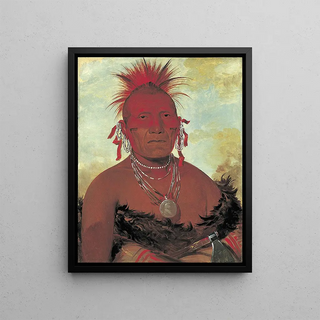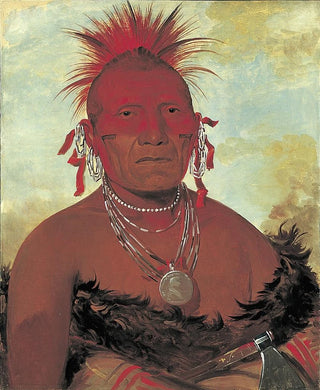Art print | Chief of the horses Shn-Ka-Ki-Hega Grand chief of the Pawnee - George Catlin


View from behind

Frame (optional)
George Catlin's artwork "Shn-Ka-Ki-Hega Chief of the Horses, Grand Chief of the Pawnee" is much more than a simple pictorial representation. It embodies an era, a culture, and a worldview that still resonate powerfully today. Immersing oneself in this piece, the viewer is transported to the heart of the American plains, where the Pawnee, a proud and resilient people, lived in harmony with nature. Catlin, a true chronicler of his time, captured not only the appearance of the figures but also the soul of a disappearing culture. This painting, with its depth and richness, invites reflection on identity, memory, and the relationship with the environment.
Style and uniqueness of the work
Catlin's style is characterized by meticulous attention to detail and a vibrant color palette that brings his subjects to life. In "Shn-Ka-Ki-Hega Chief of the Horses, Grand Chief of the Pawnee," the features of the chief are accentuated, revealing a strong and charismatic personality. The horses, symbols of power and freedom, are depicted with such precision that they almost seem to come alive before the viewer's eyes. The composition, both dynamic and balanced, highlights the intimate relationship between man and animal, emphasizing the importance of these creatures in Pawnee culture. Catlin does not merely depict historical figures; he creates an atmosphere, an ambiance that transports the viewer to another time, another space.
The artist and his influence
George Catlin, 19th-century painter and writer, dedicated his life to documenting Native American cultures through his artworks. His commitment to faithfully representing these peoples, often marginalized by mainstream history, makes him an iconic figure of American art. Catlin traveled across the United States, meeting and living with various tribes, which enabled him to create authentic portraits and scenes of daily life. His work not only contributed to the preservation of these cultures but also influenced many artists and writers across generations. By highlighting the richness

Matte finish

View from behind

Frame (optional)
George Catlin's artwork "Shn-Ka-Ki-Hega Chief of the Horses, Grand Chief of the Pawnee" is much more than a simple pictorial representation. It embodies an era, a culture, and a worldview that still resonate powerfully today. Immersing oneself in this piece, the viewer is transported to the heart of the American plains, where the Pawnee, a proud and resilient people, lived in harmony with nature. Catlin, a true chronicler of his time, captured not only the appearance of the figures but also the soul of a disappearing culture. This painting, with its depth and richness, invites reflection on identity, memory, and the relationship with the environment.
Style and uniqueness of the work
Catlin's style is characterized by meticulous attention to detail and a vibrant color palette that brings his subjects to life. In "Shn-Ka-Ki-Hega Chief of the Horses, Grand Chief of the Pawnee," the features of the chief are accentuated, revealing a strong and charismatic personality. The horses, symbols of power and freedom, are depicted with such precision that they almost seem to come alive before the viewer's eyes. The composition, both dynamic and balanced, highlights the intimate relationship between man and animal, emphasizing the importance of these creatures in Pawnee culture. Catlin does not merely depict historical figures; he creates an atmosphere, an ambiance that transports the viewer to another time, another space.
The artist and his influence
George Catlin, 19th-century painter and writer, dedicated his life to documenting Native American cultures through his artworks. His commitment to faithfully representing these peoples, often marginalized by mainstream history, makes him an iconic figure of American art. Catlin traveled across the United States, meeting and living with various tribes, which enabled him to create authentic portraits and scenes of daily life. His work not only contributed to the preservation of these cultures but also influenced many artists and writers across generations. By highlighting the richness






